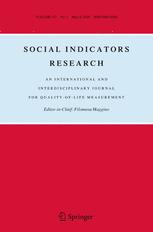 Abstract: In the last decade, Mexico, the second-largest economy in Latin America, has seen high poverty, inequality, and increasing homicide rates, which has led to widespread fear of crime. Two important challenges to understand the elevated levels of fear of crime are the lack of agreement on how to measure it and the debate on whether it responds to actual crime or to a general feeling of vulnerability associated with poverty. Moreover, there is little research in Mexico examining the complex influence of social context at the municipality level, on the relationship between person-level characteristics and fear of crime. Using Mexico’s 2015 National Survey of Victimization the goal of the study is to estimate a two-level hierarchical regression analysis combining the effects of person-level predictors and municipality level context variables to explain fear of crime in Mexico´s urban population. Our results show that some person level attributes —victimization, incivilities, trust, police effectiveness, and collective organization— are consistently associated with the three domains of fear of crime: feelings of insecurity, perceptions of risk, and avoidance behaviors. The study shows that homicide rates at the municipality level are directly associated with feelings of insecurity and avoidance behaviors. In addition, high multidimensional poverty and inequality at the municipality level amplified the rate by which incivilities affect perceptions of risk. Unexpectedly, collective efficacy at the municipality level and collective organization to solve crime at the individual level were positive and significant predictors for fear of crime in Mexico.
Abstract: In the last decade, Mexico, the second-largest economy in Latin America, has seen high poverty, inequality, and increasing homicide rates, which has led to widespread fear of crime. Two important challenges to understand the elevated levels of fear of crime are the lack of agreement on how to measure it and the debate on whether it responds to actual crime or to a general feeling of vulnerability associated with poverty. Moreover, there is little research in Mexico examining the complex influence of social context at the municipality level, on the relationship between person-level characteristics and fear of crime. Using Mexico’s 2015 National Survey of Victimization the goal of the study is to estimate a two-level hierarchical regression analysis combining the effects of person-level predictors and municipality level context variables to explain fear of crime in Mexico´s urban population. Our results show that some person level attributes —victimization, incivilities, trust, police effectiveness, and collective organization— are consistently associated with the three domains of fear of crime: feelings of insecurity, perceptions of risk, and avoidance behaviors. The study shows that homicide rates at the municipality level are directly associated with feelings of insecurity and avoidance behaviors. In addition, high multidimensional poverty and inequality at the municipality level amplified the rate by which incivilities affect perceptions of risk. Unexpectedly, collective efficacy at the municipality level and collective organization to solve crime at the individual level were positive and significant predictors for fear of crime in Mexico.
Keywords: feelings of insecurity; perceptions of risk; avoidance behaviors; multidimensional poverty; homicide rates; collective efficacy.
URL: https://link.springer.com/article/10.1007/s11205-016-1488-x



 Abstract: In the last decade, Mexico, the second-largest economy in Latin America, has seen high poverty, inequality, and increasing homicide rates, which has led to widespread fear of crime. Two important challenges to understand the elevated levels of fear of crime are the lack of agreement on how to measure it and the debate on whether it responds to actual crime or to a general feeling of vulnerability associated with poverty. Moreover, there is little research in Mexico examining the complex influence of social context at the municipality level, on the relationship between person-level characteristics and fear of crime. Using Mexico’s 2015 National Survey of Victimization the goal of the study is to estimate a two-level hierarchical regression analysis combining the effects of person-level predictors and municipality level context variables to explain fear of crime in Mexico´s urban population. Our results show that some person level attributes —victimization, incivilities, trust, police effectiveness, and collective organization— are consistently associated with the three domains of fear of crime: feelings of insecurity, perceptions of risk, and avoidance behaviors. The study shows that homicide rates at the municipality level are directly associated with feelings of insecurity and avoidance behaviors. In addition, high multidimensional poverty and inequality at the municipality level amplified the rate by which incivilities affect perceptions of risk. Unexpectedly, collective efficacy at the municipality level and collective organization to solve crime at the individual level were positive and significant predictors for fear of crime in Mexico.
Abstract: In the last decade, Mexico, the second-largest economy in Latin America, has seen high poverty, inequality, and increasing homicide rates, which has led to widespread fear of crime. Two important challenges to understand the elevated levels of fear of crime are the lack of agreement on how to measure it and the debate on whether it responds to actual crime or to a general feeling of vulnerability associated with poverty. Moreover, there is little research in Mexico examining the complex influence of social context at the municipality level, on the relationship between person-level characteristics and fear of crime. Using Mexico’s 2015 National Survey of Victimization the goal of the study is to estimate a two-level hierarchical regression analysis combining the effects of person-level predictors and municipality level context variables to explain fear of crime in Mexico´s urban population. Our results show that some person level attributes —victimization, incivilities, trust, police effectiveness, and collective organization— are consistently associated with the three domains of fear of crime: feelings of insecurity, perceptions of risk, and avoidance behaviors. The study shows that homicide rates at the municipality level are directly associated with feelings of insecurity and avoidance behaviors. In addition, high multidimensional poverty and inequality at the municipality level amplified the rate by which incivilities affect perceptions of risk. Unexpectedly, collective efficacy at the municipality level and collective organization to solve crime at the individual level were positive and significant predictors for fear of crime in Mexico. 